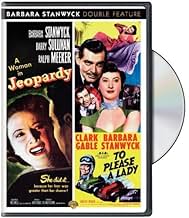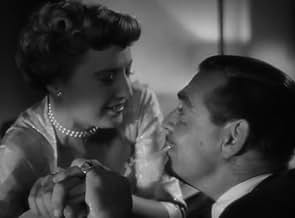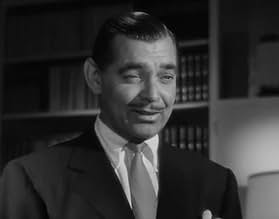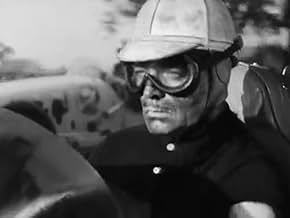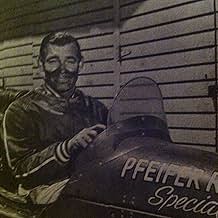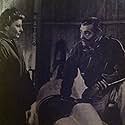Un antiguo héroe de guerra y enano corredor de autos encuentra su rival en un enérgico reportero que culpa a sus imprudentes tácticas por una muerte accidental en una carrera.Un antiguo héroe de guerra y enano corredor de autos encuentra su rival en un enérgico reportero que culpa a sus imprudentes tácticas por una muerte accidental en una carrera.Un antiguo héroe de guerra y enano corredor de autos encuentra su rival en un enérgico reportero que culpa a sus imprudentes tácticas por una muerte accidental en una carrera.
- Dirección
- Guionistas
- Elenco
- Mike's Pit Crew
- (as Lew Smith)
- Ted Husing
- (voz)
- Newspaper Editor
- (sin créditos)
- Driver
- (sin créditos)
- Pit Crew Member
- (sin créditos)
- Racing Spectator
- (sin créditos)
- Greengrove Race Spectator
- (sin créditos)
Opiniones destacadas
It took Gable's career a while to get back on track - excuse the pun - after World War II. He was older than the other matinée idols, he was a grieving widower when he returned from the war, and the indelible image he had created as Rhett Butler would haunt him. It wasn't until the mid-fifties that he really found his groove with some very good films.
This is one of the ordinary type films Gable made during this period, and here he's joined by Barbara Stanwyck as a sharp columnist. She is critical of midget car racer Gable when, during a race, another driver is killed, and he was part of the collision. She basically destroys his career in midget car racing. After some stunt driving, he earns enough to buy a car to enter the big car races. Feeling at first guilty about hurting his career, Stanwyck seeks him out while he's stunt driving; they fall for one another, but she can't get past his ruthlessness in competition.
Both stars are very good. Stanwyck did these cold businesswomen well. She's moving here into older women roles, her wonderful figure intact.
There is a lot of speedway racing in this film.
This movie is pleasant enough, but it would have been nice if stars of this stature could have been given a really top-notch script and production values.
A generation later and they're both screen legends. I would have hoped that MGM would have given them something better. It's not that it's a bad film, the racing sequences are quite good and exciting. But To Please A Lady was definitely a B picture.
I have a theory that Gable wanted to do this for pleasure. After World War II, Gable and Stanwyck's husband Robert Taylor both took up racing; motorbikes, automobiles, you name it. MGM put a stop to it, not wanting to have two of its most expensive properties out risking their necks for fun. That's why we have stunt men. It took the decline of the studio system before a newer generation of stars like James Garner, Paul Newman and most of all Steve McQueen could pursue racing without studio interference.
Gable is the race car driver and Barbara Stanwyck is the Dorothy Thompson type columnist who at first dislikes him and then falls for him big time. Lots of similarities in their relationship to Spencer Tracy and Katherine Hepburn in Woman of the Year. No comedic moments in this one though.
Both Gable and Stanwyck deserved something more memorable than To Please A Lady.
Amazingly, this is from post-war America. It feels like a movie from the 1930s, both technically and the way the story is told. Even the stars, though both obviously alive and still working, are better known for their earlier work.
I'm speaking of Clark Gable and Barbara Stanwyck. And they have a certain degree of good chemistry on screen, though the story is so "constructed" (I'm avoiding the better word "contrived") you don't always feel what they are feeling, as characters. The one scene that does this best is an extended dinner at a club where a string orchestra is playing and they fall in love and then seem to fall out of love quickly. It's really beautiful and romantic (and the strings are as lush as any string section has sounded, and I mean it).
Because of all these things this ends up being both a great fun movie and a bit of a throwback that doesn't quite take off. The director, Clarence Brown, is also known best for much earlier movies (like the award winning pre-code "A Free Soul" which is fabulous). He's good, the acting is good, and the story is, well, pretty good. It's serviceable, but a little too packaged and somewhat thin going.
Another factor here is the racing itself, the Indianapolis 500. Some of the footage is clearly from real races (probably the 1949 or 1950 race...this movie was released in the fall of 1950). There are lots of scenes--too many, unless you are car racing fan--of cars zooming around the track. Credit goes to the cinematographer, Harold Rosson, who is a bit legendary because he helped with "Wizard of Oz" and did several other classics like "Asphalt Jungle" and "The Bad Seed." The photography matters more than usual here because it's "just" car racing, and it's made exciting and visually intense. Closeups of Gable in the car are of course constructed in the studio, but seemalessly. Great visuals throughout.
See this? You bet, but remember it's really an entertainment, and it has little complexity or depth, and it has lots and lots of race track stuff that doesn't propel the plot, just the immediate energy. It's no classic, but it has classic qualities and faces, for sure, and I liked it. And in the end, without giving a thing away, the woman (Stanwyck) stays strong and keeps her independence, a rare thing in 1950s movies.
a sleeping pill. Pearls before swine. As a racer that ran at various tracks in the film,it cant be overstated how
nostalgic a trip it is to see men and race machinery the way it was in the old days; incredible doses of fun,danger and adventure. I read about these days and heard stories, but you can see in the filming that the crews and drivers
are a snapshot of true racing history in this country. Mark my words,in twenty years they are going to worship films like this one. Enjoy it now and show a friend the way it was....
Once one gets past the lousy and rather misleading title, 'To Please a Lady' is not one of those misfires and is above average in execution. It may be wanting in the story and script departments and both Gable and Stanwyck did better films before and since, especially before (no iconic stuff here). But neither bring the side down and neither does Brown in the director's chair. Even non-car racing fans should find some worth in 'To Please a Lady' as will those that are fans.
'To Please a Lady' does have a good deal done well. Gable's tough charisma and Stanwyck's steel really shine through, as do their wit and crackling chemistry. Have always gotten a lot of enjoyment out of Adolphe Menjou, he was often seen in one particularly recognisable role but he played that so well that it doesn't matter and this is no exception. All the cast do well. The racing does thrill and excite and one does get very nostalgic over seeing and recognising all the different cars. Brown's direction is lively and distinguished enough.
Although the production values are not perfect, the photography is nicely framed and slick throughout. Bronislau Kaper was a gifted composer with a number of fine scores, his one for 'To Please a Lady' is not one of his best but it fits and doesn't overbear at least. The script has some wit and the film isn't dull at least.
Having said that the story is very thin and often rather contrived, while the racing thrills some of the non-racing aspects of the story could have done with more juice. Some wit aside, the script flows rather awkwardly, can be rather trite and some lines did make me cringe.
Would have liked more development to the romance, which was convincing in chemistry but development-wise it felt unrealistically rushed. Character motivations also could have been elaborated upon more and while the photography is fine the back projection and splicing can be obvious at times.
Concluding, above average but not great. 6/10
¿Sabías que…?
- TriviaBeing in Indianapolis was difficult for Clark Gable personally. The city had been the last stop on a war bond tour in 1942 for his second wife, actress Carole Lombard, before she was to fly back home to Los Angeles. Tragically, Lombard's plane never made it back. It crashed in Nevada killing everyone on board. Theirs had been a happy marriage, and it was a loss from which Gable never recovered. At the time of Miedo de amar (1950) Gable had finally remarried, this time to Douglas Fairbanks' widow, Sylvia Ashley. During filming he seemed happier and healthier than he had in years according to friends. Even so, Gable remembered his beloved late wife while in Indianapolis. He quietly made a point to visit the downtown locations where Lombard had made her final public appearances before meeting her untimely death.
- ErroresBecause footage shot during the actual 1950 Indy 500 was used, Mauri Rose can be seen exiting the pits driving past the pit for the real car #17, Joie Chitwood (Mauri Rose and Joie Chitwood's pits were next to each other during the 1950 500 race).
- Citas
Mike Brannan: You figure on doing another column on me?
Regina Forbes: You're only worth a couple of lines now.
Mike Brannan: Well, don't write 'em! I've been risking my neck with this outfit.
Regina Forbes: I hope they pay you well.
Mike Brannan: A hundred bucks a show, and I've been saving every dime. I'm gonna drive with the big cars now, and what you wrote about me doesn't go with them. So I'm warning you. Lay off me in the future.
Regina Forbes: [Amused] You're warning me?
Mike Brannan: You better listen to what I'm saying, or I'll knock that smile off your face!
Regina Forbes: [She laughs at him] Knock it off.
[He slaps her]
Regina Forbes: That's just about what I expect from you.
Mike Brannan: The guys you run around with wouldn't do that, would they? Well, it's time somebody roughed you up a little! I can handle you, baby. You're just another dame to me!
[He grabs her suddenly, kisses her, and leaves for his car. She looks after him with a subtle smile indicating she enjoyed it]
- ConexionesEdited into Hollywood: The Dream Factory (1972)
- Bandas sonorasPolly-Wolly Doodle
(uncredited)
Credited usually to Daniel Decatur Emmett (as Dan Emmett)
Whistled by several characters
Selecciones populares
- How long is To Please a Lady?Con tecnología de Alexa
Detalles
- Fecha de lanzamiento
- País de origen
- Idioma
- También se conoce como
- To Please a Lady
- Locaciones de filmación
- Indianapolis Motor Speedway - 4790 W. 16th Street, Speedway, Indiana, Estados Unidos(1950 Indianapolis 500 race)
- Productora
- Ver más créditos de la compañía en IMDbPro
Taquilla
- Presupuesto
- USD 1,853,000 (estimado)
- Tiempo de ejecución1 hora 31 minutos
- Color
- Relación de aspecto
- 1.37 : 1
Contribuir a esta página



